Research Article
Assessment of Nutritional Anemia Among Patients Attending Kibagabaga District Hospital
4953
Views & Citations3953
Likes & Shares
Aim and objective: Anemia of nutritional origin is an acquired problem caused by consumption of diets that lack sufficient quantity of bioavailable essential hematopoietic nutrients to meet the need for hemoglobin and red blood cell synthesis. Environmental factors that expose humans to infections, such as hookworm, schistosomiasis and other parasites can lead to excessive loss or competition for hematopoietic nutrients. The objectives of this study were to determine the prevalence of nutritional anemia among patients attending Kibagabaga district hospital.
Methods: In this study both retrospective and Cross-sectional study were used. Retrospectively; Measurement and data collection were taken on patients with malnutrion suspected to have nutritional anemia. The archived data on nutrition anemia were retrieved in laboratory logbook from 15th February to 15th October 2019 while Cross-sectionally; from 20th October to 10th December 2019; Patient blood samples were collected in EDTA tubes at phlebotomy service after completing questionnaires about factors associated to nutritional anemia. The received samples were sent to the laboratory and were analyzed using Sysmex 500i automated machine.
Results: The study findings showed that overall prevalence of nutritional anemia among study participants was 90.2%. Further, 51.1% were adult females aged between 15-49 years whereas 39.1% of participants were children aged between 6-59 months. The prevalence of mild, moderate and Severe anemia was 0%, 29.3% and 9.8% in children while in women the prevalence was 9.8%; 37% and 4.3% respectively. Iron deficiency anemia was found to be a common type of nutritional anemia among study participants. The risk factors that contribute to nutritional anemia were found to be intestinal parasite infections; food supplements intake and Blood parasite infections with the prevalence of 27.2%; 23.9% and 11.9% respectively. These findings were statistically significant since p-value was equal to 0.0002 and X2=21.88).
Conclusion and recommendation: Women were more prevalent with moderate anemia compared to children. It also indicated that children with severe anemia were most prevalent compared to the women. The study assessed the risk factors (environmental factors, physiological and nutritional factors) that are associated with nutritional anemia. The findings indicated that all these factors were statistically significant means that they can lead to nutritional anemia. The ministry of Health should continue to provide micronutrient supplements to high-risk groups.
Keywords: Hemoglobin, Malnutrition, Nutritional Anemia
INTRODUCTION
Anemia is a condition characterized by a reduction in red blood cell volume and a decrease in the concentration of hemoglobin in the blood. Hemoglobin is necessary for transporting oxygen to tissues and organs in the body [1]. Nutritional anemia includes the anemia burden due to deficiency in iron along with deficiencies in folate, vitamins B and B12, and certain trace elements involved in red blood cell production. According to Ugiringabire nutritional anemia in children is associated with impaired mental and physical development and it may be a particularly serious problem for pregnant women leading to premature delivery and low birth weight.
Anemia is recognized as a major public health problem, affecting over 1.2 billion people in both the developed and developing countries [2]. Compilations of the prevalence of anemia worldwide show a large variation among regions, and although the prevalence is highest in developing countries, it is also common in industrialized countries [1]. In developed countries, prevalence of anemia is estimated at 9% while in countries with least development the prevalence is 43%. Children and women of reproductive age are highly at risk, with worldwide anemia prevalence estimates of 47% in children younger than 5 years, 42% in pregnant women, and 30% in non-pregnant women aged 15-49 years and with Africa and Asia estimating for anemia more than 85% of the absolute anemia burden in high-risk groups [3].
Several factors such as age, sex, smoking behavior and pregnancy status influence hemoglobin concentration [4]. Furthermore, anemia is an important socio-economic issue given its association with decreased physical and cognitive productivity. Previous studies have documented several potential causes of anemia among women including rural residency, young age, pregnancy status and lower nutritional status and so on [3-5]. In addition, helminths and malaria were found to be important causes of anemia [2].
Nutrition continues to be a public health concern in Rwanda. Even though, there is a strong commitment from the government, together with its development partners and educational institutions, to find solutions [6] anemia is still a severe problem among children with prevalence of 37%. Moreover, anemia is less prevalent among women than children where 19% of women have some level of anemia. The prevalence of any anemia is slightly higher among women in rural areas (20%) than women in urban areas (16%) (NISR, 2015). Besides these statistics, the prevalence of nutritional anemia is not well known among other age-group, in social classes. Therefore, this study aimed to assess the prevalence of nutritional anemia among patients attending Kibagabaga District Hospital.
Study Area
This study was conducted at laboratory of Kibagabaga District Hospital located in Kigali City, Gasabo district, Kimironko sector, and Kibagabaga cell.
Study Design
The retrospective and cross-sectional study were used. In retrospective study the archived data on patient with nutrition anemia were retrieved from laboratory logbook from 15th February to 15th October 2019 while cross-sectional study was performed from 20th October to 20th December 2019 where the qualified outpatients were approached and requested to give a voluntary consent form to enroll in the study.
Study Population
The study population were consisted patients who suggested to have nutrition anemia, attending Kibagabaga District Hospital. All patients were selectively included in the sample size of 95 non-hospitalized patients.
Inclusion Criteria
The study included all malnourished children aged between 6-59 months and women aged between 15-49 years suggested to have nutritional anemia and met other criteria for being enrolled in the study.
Exclusion Criteria
The study excluded patients with chronic diseases patients who refused to be participants and those suspected to have other types of anemia besides nutritional anemia.
Sample Collection
Patient blood samples were collected in EDTA tubes at phlebotomy service after completing questionnaires about factors associated to nutritional anemia. The blood collected in EDTA tubes were directly transported in Hematology department for complete blood count analysis.
Sample Analysis
The received samples were mixed properly; aspirated and analyzed using Sysmex 500i automated machine. The machine gave results of complete blood count (CBC). Laboratory interpretation of iron-deficiency anemia: RBC, Hb, Hct were decreased and MCV and MCH often were decreased, resulting in microcytic/hypochromic cells (RBCs tend to be small with increase central pallor because of the lack of available Hb) and for Vitamin-deficiency anemia (vitamin B12/Folic acid deficiencies): RBC, WBC, Platelet, Hb, and Hct was decreased and MCV was elevated.
Data Collection
The consent form and questionnaires were administered to the study participants. Laboratory obtained results and patients’ records from hematology service and nutrition services were used during data collection and the questionnaire were used to collect information related to the factors associated with nutritional anemias such as malnutrition, intestinal worm infection (mostly in children) and education level.
Data Analysis
Data were analyzed using statistical package for social sciences (SPSS) version 20. Descriptive statistics were used to
determine the prevalence of nutritional anemia. Univariate analysis was used to assess the association of the risk factors with nutritional anemia. Factors indicated an association with nutritional anemia at a p-value
Ethical Considerations
At high level, the clearance form obtained from INES-Ruhengeri was submitted to the ethic Committee of Kibagabaga District Hospital with a motivation letter requesting for data collection and this research proposal at the same time. After approval, a copy of approval letter was submitted to the laboratory director who informed the head of Hematology unit and nutrition services through the laboratory manager. The patient’s anonymity and confidentiality were assured by using only lab number as code instead of their names.
Socio-Demographic Characteristics of Patients with Nutritional Anemia
The results about demographic information of study participants with nutritional anemia at Kibagabaga Hospital were presented based age, sex in children and age in women as shown in the following section.
Socio-Demographic Characteristics of Children with Nutritional Anemia
Figure 1 presents socio-demographic characteristics with nutritional anemia for children aged from 6-59 months.
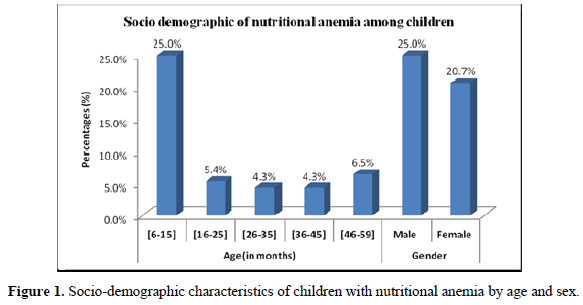
The results show that 25.0% of children during periods of the study were aged between 6-15 months. The findings also indicate that male was 25.0% whereas 20.7% were female children with nutritional anemia. The results indicates that children age between 6-15 months were prone to nutritional anemia because it is the beginning of feeding other food besides of breastmilk so if there is inappropriate hygiene or feeding food with not containing enough essential nutrients leads to nutritional anemia. These results were in agreement with the study done by Alemayehu [1] found that the prevalence of anemia was highest (85.4%) among children between 6 months and 11 months of age. The prevalence of anemia different significantly by age group (P=0.007). The prevalence of anemia was 80.4% and 80.3% among male and female children respectively.
Socio-Demographic Characteristics of Women with Nutritional Anemia According to Age Groups
The study also aimed to assess the socio-demographic characteristics of women with nutritional anemia according to their age groups.
21.7% of women participated in the study were aged between 15-19 years, followed by 15.2% of women were aged between 20-29 years. In addition, women aged between 40-49 years were 5.4% as illustrated in Figure 2. The findings imply that the majority of women with nutritional anemia were aged between 15-19 years because this is the period of high growth which is required enough essential nutrients.
According to Petry [7] stated that regular blood loss that occurs with menstruation increases iron losses and thus iron requirements. Periods of high growth and development during adolescence and pregnancy incur significant additional iron needs. Women may also experience significant iron loss from bleeding in childbirth, and diets that are low in bioavailable iron are common among women and adolescents in many low- and middle-income countries. Ziegler [8] noted that pregnant adolescents are at particular risk of developing anemia, not only because of their dual iron requirements (for their own growth and for the growth of the fetus), but because they are also less likely to access antenatal care.
Prevalence of Nutritional Anemia Among Patients Attending Kibagabaga Hospital
Nutritional anemia result when the intake of certain nutrients is insufficient to meet the demands for synthesis of hemoglobin and erythrocytes.
As shown on the Figure 3, the women were more prevalent with moderate anemia counting 37.0% compared to the
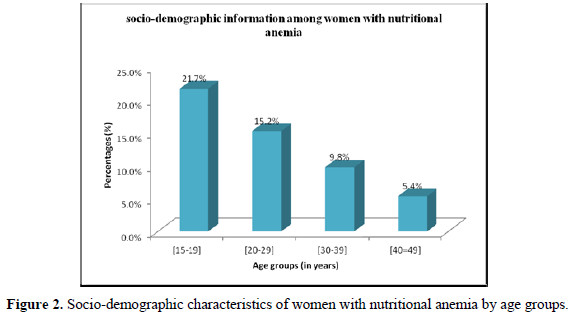
prevalence of children with 29.3%. It also indicates that children with severe anemia were most prevalent presenting 9.8% compared to the prevalence of women counting 4.3%. The prevalence of mild anemia was also 9.8% women with nutritional anemia.
Additionally, iron-deficiency anemia is common in infants and young children, owing to the high iron requirements needed for their rapid growth and development, particularly during the first 2 years of life [1]. Global data on the prevalence and causes of anemia among the elderly are limited, but it is known that the prevalence of anemia increases with age, starting at the age of 50 years, and that anemia affects men in this age group more commonly than women [9].
Moreover, children under 5 years of age in the WHO African Region represented the highest proportion of individuals affected with anemia (62.3%), while the greatest number of children and women with anemia resided in the WHO South-East Asia Region, including 190 million non-pregnant women, 11.5 million pregnant women, and 96.7 million children aged under 5 years [10]. In Rwanda, the data show that anemia is less prevalent among women than children; 19 percent of women in Rwanda have some level of anemia, as compared with 37 percent of children. The great majority of women with anemia are mildly anemic (16 percent); 3 percent are moderately anemic, and almost none are severely anemic [11].
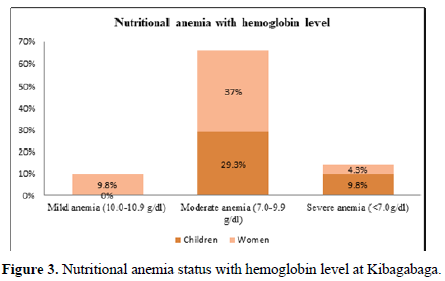
Classification of Nutritional Anemia Based on Red Blood Cell Indices
Nutritional anemia among both children and women attending Kibagabaga hospital was assessed this study according to red blood cell indices as shown in Table 1.
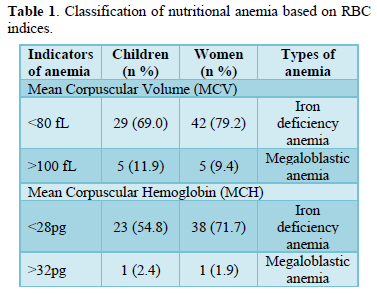
Table 1 indicated that 79.2% of women were had iron deficiency anemia compared to the children with 69.0% of children participated in this study. This is because women may loss much iron during the menses. Other patients had megaloblastic anemia. This is in agreement with Goodnough and Schrier [9] iron deficiency develops when dietary iron intake cannot meet iron needs (e.g., owing to poor diet, or impaired absorption from high intake of phytates or phenolic compounds), especially during periods of life when iron requirements are especially high (i.e., during infancy and pregnancy), or iron losses exceed iron intake (e.g., from blood loss from parasites, childbirth or menstruation) over a period of time.
Risk Factors Associated to Nutritional Anemia Among Patients Attending Kibagabaga Hospital
Table 2 indicates the risk factors that are associated with nutritional anemia.
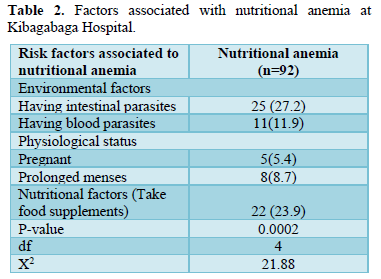
Table 2 also shows that 27.2% of patients were infected with intestinal parasites which may lead to nutritional anemia. 23.9% of patients took any food supplements and 11.9% had blood parasites. These findings were statistically significant since p-value was equal to 0.0002 and X2=21.88). Nutritional anemia origin is acquired problem caused by diets that lack sufficient quantity of bioavailable essential hematopoietic nutrients to meet the need for hemoglobin and red blood cell synthesis. Need is influenced by environmental factors that cause excessive blood loss or hemolysis [7].
Other study showed that Kassebaum [10] infectious diseases can cause anemia through multiple mechanisms, including impaired nutrient absorption and metabolism, ineffective erythropoiesis, or increased nutrient losses. This group is also at increased risk of developing iron deficiency and anemia, for several reasons. Regular blood loss that occurs with menstruation increases iron losses and thus iron requirements. Periods of high growth and development during adolescence and pregnancy incur significant additional iron needs [8]. Pregnant adolescents are at particular risk of developing anemia not only because of their dual iron requirements, but because they are also less likely to access antenatal care [9].
The most common causes of anemia in Rwanda are inadequate dietary intake of iron, malaria, and intestinal worm infection. Iron and folic acid supplementation and anti-malarial prophylaxis for pregnant women, promotion of the use of insecticide-treated bed nets by pregnant women and children under age 5, and six-month deworming for children age 2 to 5 are some of the important measures to reduce the anemia burden among vulnerable groups [11].
Conclusions
Anemia of nutritional origin is acquired problem caused by diets that lack sufficient quantity of bioavailable essential hematopoietic nutrients to meet the need for hemoglobin and red blood cell synthesis. Environmental factors that expose humans to infections, such as hookworm, schistosomiasis and other parasites can lead to excessive loss or competition for hematopoietic nutrients. To conclude, women were more prevalent with moderate anemia compared to the prevalence of children. It also indicates that children with severe anemia were most prevalent compared to the prevalence of women. The study assessed the risk factors (environmental factors, physiological and nutritional factors) that are associated with nutritional anemia. The findings indicated that all these factors were statistically significant means that they can lead to nutritional anemia.
Recommendations
The study recommends the following: The ministry of Health should continue to provide micronutrient supplements to high-risk groups. Advocacy can also be directed at the public, to increase their use, and demand for, anemia services, as well as at health professionals, to increase or improve their implementation of anemia-prevention actions. Kibagabaga Hospital should make much effort to control parasitic infections by teaching the importance of food and home hygiene. It should also continue to teach and sensitize on the importance of taking iron and folic acid supplements.
- Alemayehu B, Marelign T, Aleme M (2016) Prevalence of anemia and its associated factors among pregnant women attending antenatal care in health institutions of Arba Minch Town, Gamo Gofa Zone, Ethiopia: a cross-sectional study. Hindawi Publishing Corporation. Anemia 1(1): 1-10.
- Gautam S, Min H, Kim H, Jeong H (2019) Determining factors for the prevalence of anemia in women of reproductive age in Nepal: Evidence from recent national survey data. PLoS One 14(6): 1-6.
- Mohammed YM, Akabat AA, Al-Shammakh AA, Abdulelah HA, Abdullatif DA (2017) Prevalence and associated factors of anemia among pregnant women residing at high altitude in Yemen. Am J Health Res 5(4): 93-98.
- Mujica-Coopman MF, Brito A, de Romaña DL, Ríos-Castillo I, Coris H, et al. Prevalence of anemia in Latin America and the Caribbean. Food Nutr Bull 36(2): 1-10.
- Nawal S (2014) Prevalence of iron deficiency anemia etiological and prevention. Eur J Biol Med Sci Res 2(2): 55-60.
- Mukankubana MA (2017). Effect of malnutrition on anemia development among children under five years attending Nemba Hospital (Unpublished memoire). INES-Ruhengeri, Musanze.
- Petry N, Olofin I, Hurrell R, Boy E, Wirth J, et al. (2016) The proportion of anemia associated with iron deficiency in low, medium, and high human development index countries: A systematic analysis of national surveys. Nutrients 8(11): 693-
- Ziegler EE, Nelson SE, Jeter JM (2014) Iron stores of breastfed infants during the first year of life. Nutrients 6(5): 2023-2034.
- Goodnough LT, Schrier SL (2014) Evaluation and management of anemia in the elderly. Am J Hematol 89(1): 88-
- Kassebaum NJ (2016) The global burden of anemia. Hematol Oncol Clin North Am 30(2): 247-
- Mugisha JO, Baisley K, Asiki G, Seeley J, Kuper H (2013) Prevalence, types, risk factors and clinical correlates of anemia in older people in a rural Ugandan p PLoS One 8(10): 1-10.
QUICK LINKS
- SUBMIT MANUSCRIPT
- RECOMMEND THE JOURNAL
-
SUBSCRIBE FOR ALERTS
RELATED JOURNALS
- Journal of Blood Transfusions and Diseases (ISSN:2641-4023)
- Journal of Otolaryngology and Neurotology Research(ISSN:2641-6956)
- Journal of Allergy Research (ISSN:2642-326X)
- Journal of Carcinogenesis and Mutagenesis Research (ISSN: 2643-0541)
- Chemotherapy Research Journal (ISSN:2642-0236)
- International Journal of Internal Medicine and Geriatrics (ISSN: 2689-7687)
- International Journal of Medical and Clinical Imaging (ISSN:2573-1084)





